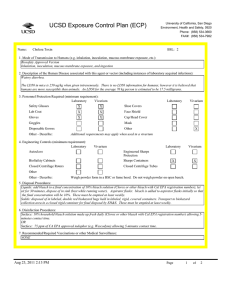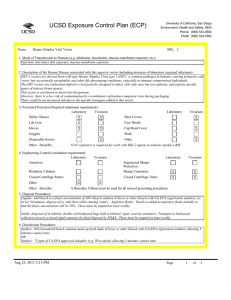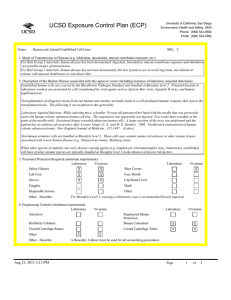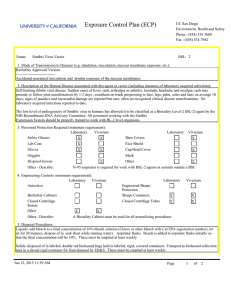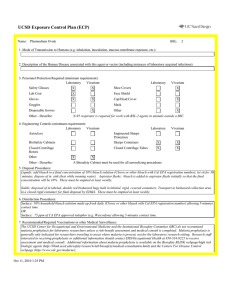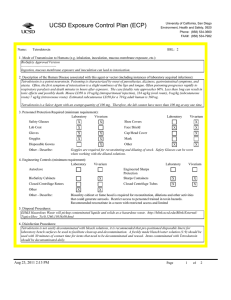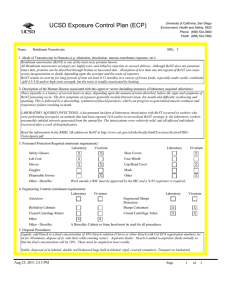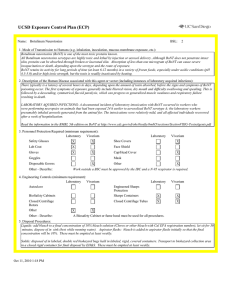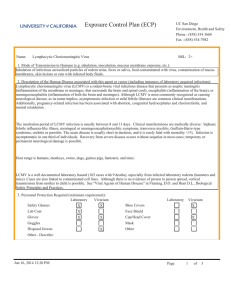UCSD Exposure Control Plan (ECP)
advertisement
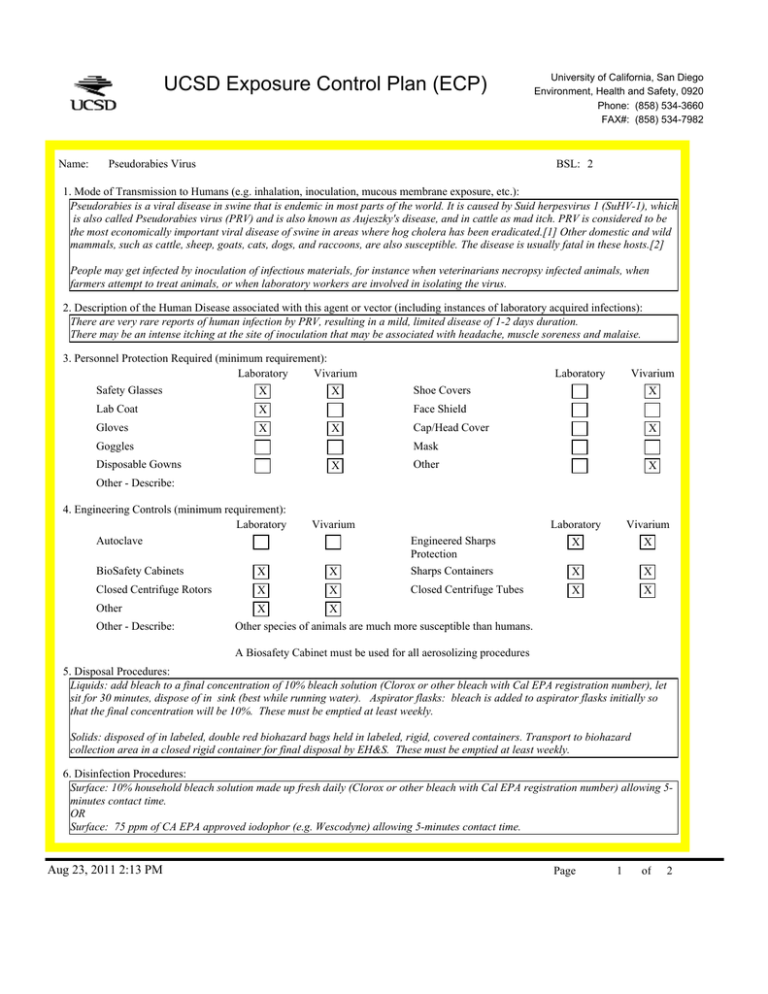
UCSD Exposure Control Plan (ECP) Name: Pseudorabies Virus University of California, San Diego Environment, Health and Safety, 0920 Phone: (858) 534-3660 FAX#: (858) 534-7982 BSL: 2 1. Mode of Transmission to Humans (e.g. inhalation, inoculation, mucous membrane exposure, etc.): Pseudorabies is a viral disease in swine that is endemic in most parts of the world. It is caused by Suid herpesvirus 1 (SuHV-1), which is also called Pseudorabies virus (PRV) and is also known as Aujeszky's disease, and in cattle as mad itch. PRV is considered to be the most economically important viral disease of swine in areas where hog cholera has been eradicated.[1] Other domestic and wild mammals, such as cattle, sheep, goats, cats, dogs, and raccoons, are also susceptible. The disease is usually fatal in these hosts.[2] People may get infected by inoculation of infectious materials, for instance when veterinarians necropsy infected animals, when farmers attempt to treat animals, or when laboratory workers are involved in isolating the virus. 2. Description of the Human Disease associated with this agent or vector (including instances of laboratory acquired infections): There are very rare reports of human infection by PRV, resulting in a mild, limited disease of 1-2 days duration. There may be an intense itching at the site of inoculation that may be associated with headache, muscle soreness and malaise. 3. Personnel Protection Required (minimum requirement): Laboratory Vivarium Safety Glasses X X Lab Coat X Gloves X Laboratory Vivarium Shoe Covers X Face Shield X Goggles Cap/Head Cover X Mask Disposable Gowns X Other X Other - Describe: 4. Engineering Controls (minimum requirement): Laboratory Autoclave Vivarium BioSafety Cabinets X X Engineered Sharps Protection Sharps Containers Closed Centrifuge Rotors X X Closed Centrifuge Tubes X X Other Other - Describe: Laboratory Vivarium X X X X X X Other species of animals are much more susceptible than humans. A Biosafety Cabinet must be used for all aerosolizing procedures 5. Disposal Procedures: Liquids: add bleach to a final concentration of 10% bleach solution (Clorox or other bleach with Cal EPA registration number), let sit for 30 minutes, dispose of in sink (best while running water). Aspirator flasks: bleach is added to aspirator flasks initially so that the final concentration will be 10%. These must be emptied at least weekly. Solids: disposed of in labeled, double red biohazard bags held in labeled, rigid, covered containers. Transport to biohazard collection area in a closed rigid container for final disposal by EH&S. These must be emptied at least weekly. 6. Disinfection Procedures: Surface: 10% household bleach solution made up fresh daily (Clorox or other bleach with Cal EPA registration number) allowing 5minutes contact time. OR Surface: 75 ppm of CA EPA approved iodophor (e.g. Wescodyne) allowing 5-minutes contact time. Aug 23, 2011 2:13 PM Page 1 of 2 UCSD Exposure Control Plan (ECP) 7. Recommended/Required Vaccinations or other Medical Surveillance: No vaccinations are recommended or required. 8. Employee Exposures- first aid procedures: a.Eye exposure from splash or aerosols - rinse a minimum of 15 minutes in eye wash or flush area with water. b.Skin exposure - wash area with soap and water for 15 minutes c.Needle stick and/or sharps exposure - wash wound area with soap and water for 15 minutes d.Contamination of clothing - remove the contaminated clothing and place in biohazard bag, shower with the emergency douse shower, and put on clean clothes. e.Spill or release - Monday through Friday, 8a - 4:30p call EH&S at (858-5343660); after hours call UCSD Police (858-534-4357) 9. Employee Exposure - seek medical follow-up from the following medical providers: (TAKE THIS ECP WITH YOU) Monday - Friday, 8a - 4:30p: UCSD Occupational & Environmental Medicine, (619) 471-9210 24-hour walk-in service: Thornton Hospital Emergency Room, (858) 657-7600 UCSD Medical Center (Hillcrest) Emergency Room, (619) 543-6400 10. Report All Injuries, Illnesses, and Exposures to EH&S: Complete the information found on "What to Do if a Work-Related Injury or Illness Occurs" (http://blink.ucsd.edu/Blink/External/ Topics/How_To/0,1260,4295,00.html) 11. Required Biosafety Training: Laboratory specific training on hazards, exposure evaluations, and the required precautions for experimental procedures used with this agent - provided by Principal Investigator 12. Lab specific instructions: Procedure listed in protocol S02174M. Proper safety precautions include the use of lates gloves, googles or face shield, lab coat is used when moving animal. Administration of this agent is to be performed by research staff. The preparation of this agent is done in a chemical fume hood. Aug 23, 2011 2:13 PM Page 2 of 2
